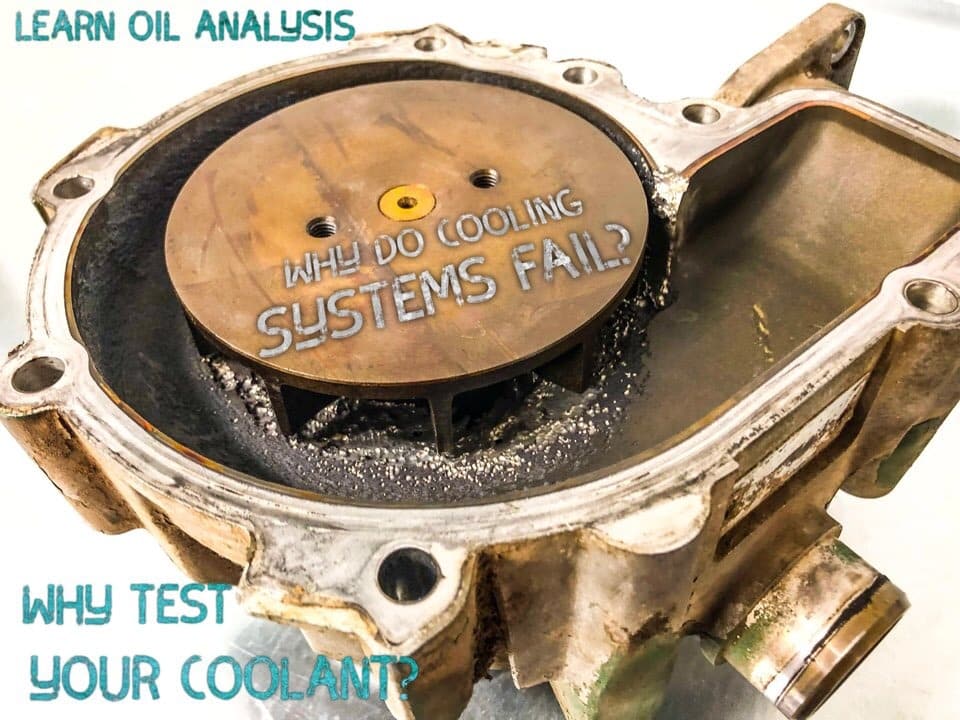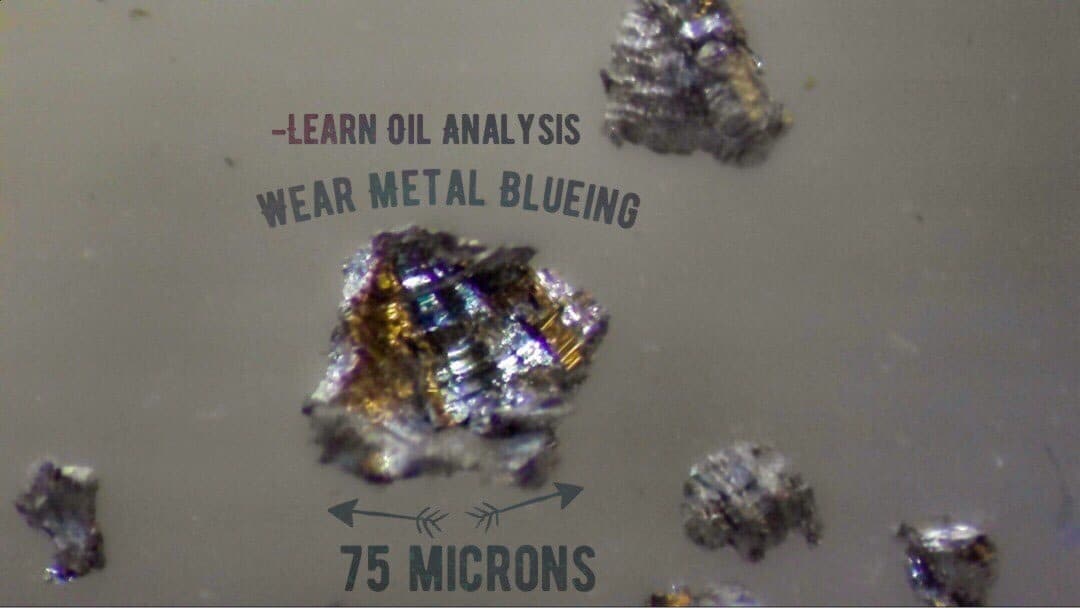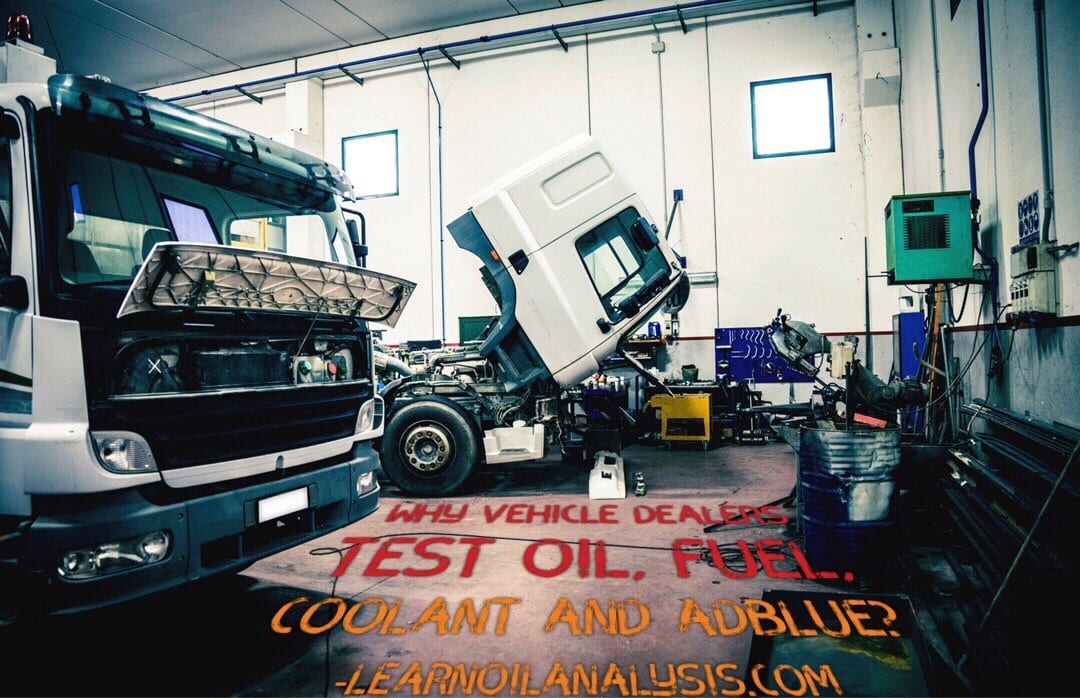Oil, coolant, AdBlue (also known as Diesel Exhaust Fluid (DEF) in North America) and fuel analysis has been used on vehicles all over the world for decades. This is usually done by vehicle operators to reduce unplanned downtime, fuel consumption and the repair costs of preventable failures.
However, over the last 10 years it is also being used by the OEMs themselves not just as a condition monitoring package to provide to customers but a key diagnostic tool when a vehicle enters a dealership with a fault.
Samples from vehicles with a range of symptoms are now having fluid samples taken to help diagnose the issue. Symptoms such as:
- Knocks and misfires.
- NOx alerts, SCR and EGR problems.
- Injector and other fuel system failures.
- Castrophic engine and gear failures.
- Poor fuel economy.
- Engine warning lights.
- Engine Overheating.
- Slipping transmissions.
- Coolant leaks.
- Blocked filters
- Excessive Oil consumption
- Coated catalytic converter bricks
- Blocked diesel particulate filters (DPF)
They are even taking samples of filters or deposits to identify causes of blockages, failure mechanism causes, to prove evidence of contamination or identify the cause of a material found in the system.
Why is there a large uptake in vehicle dealers fluid sampling now?
In simple, technology in lab analysis has moved on from the traditional methods. Traditional fluid analysis, particularly of lubricants has always relied on building trends across time, which is brilliant for regular oil analysis users, but for vehicle warranty purposes has been rather poor as these tend to be taken as one off adhoc samples. This meant diagnoses by labs tended to be rather vague unless there was something clearly wrong with the sample.
Equally, most the tests on an oil analysis report are the wear metals, but this has a fundamental flaw in that the technology that nearly all labs use misses 2/3rds of normal wear and all the abnormally sized particles meaning they can never get the true picture of what is happening in the vehicle.
In 2018 these two problems were solved by Oil Analysis Laboratories with a new technology called LubeWear, which detects all the wear particles and can not only tell if wear is present, but the significance too. Meaning failures can be detected earlier for regular lab analysis users, but more importantly for the vehicle market they can diagnose faults on a single sample with no history.
Learnoilanalysis.com did a feature on this which you can read here.
Naturally, it is not hard to see why the vehicle dealerships and truck fleet users were some of the earliest to take advantage of this new technology and start using fluid analysis more regularly.
How it helps?
Fluid analysis helps by:
- Speeding up fault diagnostics meaning vehicles can be back on the road sooner as opposed to shipping the part or vehicle abroad to the OEM headquarters.
- Impartially identifying causes of vehicle faults as an independent 3rd party giving confidence and assurance to both dealers and end customers.
- Help confirm the validity of a warranty claim.
- Aid in vehicle trade-ins to identify general mechanical and fluid systems health.
- Screening fleets for research of engine performance and known vehicle issues before they cause issues for customers.
It can aid in detecting problems such as:
Oils and Greases
- Fuel leaks
- Blow-by
- Coolant leaks
- Air filtration problems
- Failing components such as bearings
- Use of non OEM/recommended oil
- Use of wrong type of oil e.g. ATF oil in an manual or EP gearbox system.
- Sabotage / accidental introduction of contaminants.
- Evidence of overheated or over-used oil beyond the recommended drain intervals.
Diesel Fuels
- Dirty or contaminated fuel.
- Fuel bugs
- Wet fuel
- Petrol in diesel
- Red diesel in white diesel systems.
- Engine oil in diesel either in operator error or seal leaks.
- Use of too high biodiesel content above EN590.
- Testing to confirm if consistent with EN590 road diesel.
- Degraded or poor quality biodiesel.
- Fuel supplier or forecourt issues.
- Mixing with coolant or AdBlue.
Engine Coolants
- Under concentration
- Over concentration
- Depleted corrosion inhibitor additives
- System corrosion
- Sabotage / accidental mixing with AdBlue, screen wash, diesel or engine oil.
- Coolant leaks
AdBlue / DEF
- Poor quality AdBlue, poor storage and transport conditions by testing to ISO22241-2 Spec.
- Contamination with coolant, fuel, oil, screen wash
- Presence of catalyst poisons.
Filters
- Causes of blockage
- Catastrophic failure mechanisms
- Evidence of contamination when the fluid is no longer present e.g. misfuelling several fills before bringing to dealer with a problem.
Components
- Identification of elemental metals and organic composition of deposits.
- Identification of wear modes on exposed component surfaces.
Need more proof? Here are some interesting case studies of vehicle dealers using fluid analysis.
There are many weird and unusual failure mechanisms fluid analysis investigative chemists can help dealers and fleet owners identify the cause of vehicle problems.
Case study 1 – water pump failures


In this example the customer was having repeated water pump failures and the OEM part manufacturers of the pump was unable to highlight the cause. During this time the part clocked up several thousand air miles going through numerous parts investigation teams trying to identify the cause. It was believed to be erosion from high particulates in the coolant. However, the question was how as this was affecting numerous vehicles. Finally Oil Analysis Laboratories was involved, first with coolant samples which appeared in perfect condition and free from contamination. This allowed ruling out of erosion suggesting it was more likely cavitation. One of the account managers from the lab went through with the customer any maintenance activities. It was found that there was regular replacement of hoses (a non genuine part) because they were “disintegrating”. It was explained that the breakdown of the hoses could introduce air entrainment that could cause the cavitation seen. The hose type was switched to the recommended type on all the other vehicles having not yet failed in the fleet and the problem, as of writing, has not reoccurred. Hence fluid analysis is useful not just for ruling in problems but ruling out causes too to prevent failure investigations barking up the wrong tree.
Case study 2 – OEM screening of cooling system leaks
A well known vehicle manufacturer was experiencing problems with an increase in engine failures under warranty after releasing a new vehicle model. Unsure of why the high failure rate, the OEM started doing regular oil analysis. The analysis found that there was significant abnormal bearing wear and coolant ingress in each of the examples and when the bearings were examined there was considerable wear colloquially called “wiping”.
Microscopic analysis also showed wear metals with “blueing” consistent with high temperatures. This fits the pattern of denser coolant removing the lubricant film at the loaded bottom of the bearing, causing metal to metal contact and high temperatures at point of failure.

Further investigation with the OEM head office R&D team managed to track down the fault to an individual component batch which was causing the coolant leak. They subsequently ammended their supply chain processes and rectified the fault on future releases of the engine. However the existing engines out in the marketplace needed addressing that could also potentially have the issue, so the OEM decided to provide free fluid analysis to all owners of these vehicles (those in the affected batch and those that were not) for the life of the warranty, which actually generated more sales as customers liked the free service. The cost savings were found to be huge with the estimated cost of replacing the part on affected vehicles to be ~£150 Vs the cost of the engine rebuild following a failure being ~£25k.
The OEM decided to continue the use of the programme on future new releases of models to identify faults before there was an increase in failures and also to help in development of new engines in future.
Case study 3 – white deposit in engine
An engine oil sample was sent after a white deposit was found in the engine upper cylinders. The dealer believed this to be AdBlue where the urea was left behind after the water boiling off. The dealer provided engine oil, AdBlue and fuel samples for analysis. Unfortunately the dealer was unable to obtain the deposit as they had already repaired the engine before taking samples. The AdBlue and fuel were found to be in good condition, but the oil showed a very high Calcium value of ~8000ppm (0.8%). This is exceptionally high and only usually seen in specialist lubricants designed to cope with very acidic conditions and never in the UK vehicle market as the sulphated ash (SAPS) limits to reduce vehicle pollution prevent this. The Calcium present was found to have been added by the end vehicle owner using an aftermarket additive package at too high a concentration. This had created an incredible amount of white ash and blocked the Diesel Particulate Filters.
Case study 4 – SCR system faults with suspected contamination.
This is a real Sherlock Holmes type investigation, and one of the most interesting cases I have come across. The dealer had a vehicle come into the dealership with what appeared to be a contaminated AdBlue tank with a liquid residue seen in the tank. The dealer took a couple photos of the inside of the tank, flushed and refilled with fresh AdBlue and informed the end user this was not something that would be covered under warranty as the system was contaminated. The customer filed a dispute about the rejection of the claim a week after taking the vehicle away, meaning the dealer was left in an awkward situation as they had thrown away the chemical evidence the system had been contaminated. The vehicle was brought back into the dealership and thankfully the filter was not replaced. However, the filter had been flushed with AdBlue for a full week of the vehicle running following the repair meaning there was little hope of their being any of the suspcted liquid contamination left. The filter was sent to the lab anyway. The only aspect that looked unusual was a glue type material covering the filter in globules. All liquids extracted were consistent with AdBlue as would be expected.
The lab asked the dealer for a new filter for comparison to see if this glue was supposed to be part of the filter or a contaminant. It turned out is was a very thin water-resistant coating to protect paper parts of the filter. However it appeared the material had been dissolved and then precipitated on the filter again. This would fit the pattern of a solvent being added to the tank, slightly dissolving the glue in the filter, which on flushing the tank and refilling with AdBlue, the glue was no longer soluble and started to precipitate out and coat the filter in clumps.
The lab went through a list of commonly used chemicals the customer could have had access to that created this pattern and it turned out to be screen wash. On this basis the warranty claim was able to be rejected.
The moral of the story is to always sample when you suspect fluid contamination in a vehicle to obtain a definitive and independent report. It also shows that even when all hope is lost to finding the cause of a failure that Oil Analysis Laboratories can still help you for when failure is not an option.
Case study 5 – fuel system faults across a whole geographical region.
From time to time, fuel at the forecourts can have problems or be contaminated. You have probably heard of occurances of this in the news when big name fuel suppliers, or supermarket fuel stations have had problems with their fuel. This is a relatively rare occurances, but when you think of how much fuel we consume each day ~130 million litres in the UK alone (based on HM treasury statistics) even imagining a 1 in a million chance of producing a bad batch would leave 130 litres of contaminated fuel a day.
Poor quality fuel shouldn’t happen, as fuel suppliers have to by law have their fuel tested to confirm it meets EN590 specification, which it will have to have done to be be sold. However, contamination can occur at any point before entering the vehicle. This is because the distribution, storage and even the sample taking of the bulk storage can all have problems meaning that contamination does end up in vehicles.
Equally, low level additives added to provide beneficial effects to the fuel when concentrated in high doses can cause problems such as blocked filters.
If you imagine a fuel station consisting of huge underground tanks with vehicles coming and draining off from the bottom, a prolonged period of no agitation can lead to water and dirt settling to the bottom of the tank and immiscible additives such as antifoam rising to the top. Depending on which time of day you fill up you could be unfortunate enough to draw the highly concentrated contamination from the bottom of the tank or draw almost pure additives when tank levels are low. Either case can cause problems, which if fully homogenised would unlikely show any problems.
The presence of biodiesel adds an additional complexity as it is very sensitive to water contamination causing it to split chemically into fatty acids and glycerol. So some forecourts do monitor cleanliness and use fuel polishing and tank sampling processes to maintain clean tanks.
The first people to be aware of a forecourt fuel issue are unlikely to be the fuel suppliers. Having spoken to one of the leading UK supermarkets fuel technical managers it can take up to 6 weeks to investigate a fuel complaint, which by that time the tank contents have been turned over multiple times with multiple fills.
Hence the first sign of any problem is usually noticed by the vehicle dealers when they see a spike in fuel system faults.
Some dealers and OEMs have taken matters into their own hands and sampled problem forecourts fuel to test for excessive contamination to file complaints for the costs of the vehicle repairs while the issue is still current.
In the past we have worked with multiple OEMs to help confirm the presence of contaminated fuel at forecourts as well as help clear other forecourts as the source of the fuel issues. This was achieved by the dealers doing regular trips to take samples across the day to identify peak times for contamination. These tend to be ongoing projects as fuel contamination can occur both as one off events at a single forecourt, or have seasonal and episodic variations linked to single fuel suppliers or imports.


